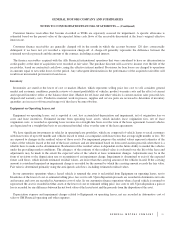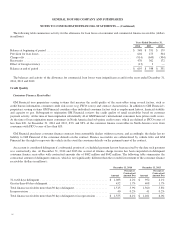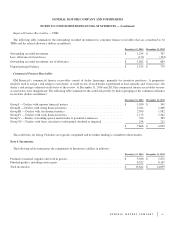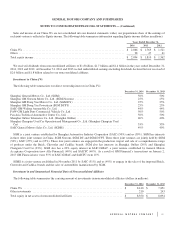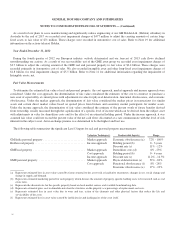General Motors 2014 Annual Report Download - page 80
Download and view the complete annual report
Please find page 80 of the 2014 General Motors annual report below. You can navigate through the pages in the report by either clicking on the pages listed below, or by using the keyword search tool below to find specific information within the annual report.GENERAL MOTORS COMPANY AND SUBSIDIARIES
NOTES TO CONSOLIDATED FINANCIAL STATEMENTS — (Continued)
statutory tax rates in effect for the year in which the differences are expected to reverse. The effect on deferred tax assets and
liabilities of a change in tax rates is recorded in the results of operations in the period that includes the enactment date under the law.
Deferred income tax assets are evaluated quarterly to determine if valuation allowances are required or should be adjusted. We
establish valuation allowances for deferred tax assets based on a more likely than not standard. The ability to realize deferred tax
assets depends on the ability to generate sufficient taxable income within the carryback or carryforward periods provided for in the tax
law for each applicable tax jurisdiction. The assessment regarding whether a valuation allowance is required or should be adjusted
also considers all available positive and negative evidence factors. It is difficult to conclude a valuation allowance is not required
when there is significant objective and verifiable negative evidence, such as cumulative losses in recent years. We utilize a rolling
three years of actual and current year results as the primary measure of cumulative losses in recent years.
Income tax expense (benefit) for the year is allocated between continuing operations and other categories of income such as Other
comprehensive income (loss). In periods in which there is a pre-tax loss from continuing operations and pre-tax income in another income
category, the tax benefit allocated to continuing operations is determined by taking into account the pre-tax income of other categories.
We record uncertain tax positions on the basis of a two-step process whereby: (1) we determine whether it is more likely than not
that the tax positions will be sustained based on the technical merits of the position; and (2) for those tax positions that meet the more
likely than not recognition, we recognize the largest amount of tax benefit that is greater than 50% likely to be realized upon ultimate
settlement with the related tax authority. We record interest and penalties on uncertain tax positions in Income tax expense (benefit).
Foreign Currency Transactions and Translation
The assets and liabilities of foreign subsidiaries that use the local currency as their functional currency are translated to U.S. Dollars
based on the current exchange rate prevailing at each balance sheet date and any resulting translation adjustments are included in
Accumulated other comprehensive loss. The assets and liabilities of foreign subsidiaries whose local currency is not their functional
currency are remeasured from their local currency to their functional currency and then translated to U.S. Dollars. Revenues and
expenses are translated into U.S. Dollars using the average exchange rates prevailing for each period presented.
Gains and losses arising from foreign currency transactions and the effects of remeasurements discussed in the preceding paragraph
are recorded in Automotive cost of sales and GM Financial operating and other expenses unless related to Automotive debt, which are
recorded in Interest income and other non-operating income, net. Foreign currency transaction and remeasurement losses were $437
million, $350 million and $117 million in the years ended December 31, 2014, 2013 and 2012.
Accounting Standards Not Yet Adopted
In May 2014 the Financial Accounting Standards Board issued Accounting Standards Update (ASU) 2014-09, “Revenue from
Contracts with Customers” (ASU 2014-09) which requires companies to recognize revenue when a customer obtains control rather
than when companies have transferred substantially all risks and rewards of a good or service. This update is effective for annual
reporting periods beginning on or after December 15, 2016 and interim periods therein and requires expanded disclosures. We are
currently assessing the impact the adoption of ASU 2014-09 will have on our consolidated financial statements.
Note 3. Acquisition of Businesses
Acquisition of Certain Ally Financial International Operations
In November 2012 GM Financial entered into a definitive agreement with Ally Financial to acquire 100% of the outstanding equity
interests in the top level holding companies of its automotive finance and financial services operations in Europe and Latin America
and a separate agreement to acquire Ally Financial’s non-controlling equity interest in SAIC-GMAC, which conducts automotive
finance and other financial services in China.
80







